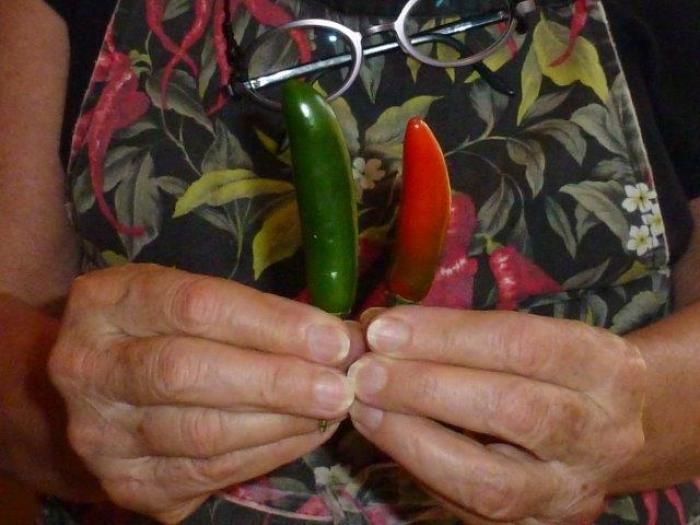
The International Herb Association has chosen Capsicum as Herb of the Year for 2016. I am a confessed chilehead and have been perusing seed catalogs for my favorite chiles, as well as for new selections (or new to me) to feature in this year’s garden beds. See my favorites below–and why they are thus so. Here’s to a hot and spicy year ahead!
Here are chiles that I feel are must haves that I cannot live without and I cultivate them every year:
1. Serranos–good all purpose heat and flavor; smaller and hotter than a jalapeño, eat green to red, fresh and dried.
2. Jalapeños–most common chile pepper in U.S.; can be not very hot to medium heat (when these are smoke-dried they are called chipotles).
3. Poblanos–range from mild heat to medium hot and have a great flavor when roasted and peeled (large heart-shaped peppers that are used for making chile rellenos; when dried they are called anchos).
4. ‘New Mexico’ or ‘Anaheim’ cultivars–made popular by Hatch chiles–these come mild, medium, hot and extra hot (these are the southwest green chiles which are roasted and peeled for making green chile sauce or allowed to turn red and hung on ristras). ‘New Mexico 6’ and ‘Big Jim’ are included here.
5. ‘Fish’ peppers–fairly recently reintroduced heirloom chile, about 2-inches long, starts out cream-colored with green striations, turns yellow to orange, then red, thin-walled; makes an excellent concentrated, fermented hot sauce like Tabasco.
Proceeding further in to the capsicum realm… I pretty much always grow:
6. Cayenne–long, thin red chile, great for drying and grinding to a powder; an essential on the spice rack.
7. Thai–small, pungent chiles, start geen and ripen to red, intense heat dissipates fairly quickly, use fresh or dries well.
8. Tabasco–trademarked by McIlhenny Company, this tall plant with small hot chiles starting green to yellow, then orange to red, chiles are used in making the famous Tabasco sauce; I grow them to ferment my own.
9. ‘Santa Fe Grande’–medium-size chile, medium to medium hot, can be eaten lime green, yellow or orange, matures to scarlet, good fresh, makes a good pickled pepper.
10. Paprika (both sweet and hot varieties)–these long thick-walled pods turn red and can be eaten fresh or are dried and ground for sweet paprika or half-sharp, both essential cooking ingredients.
11. ‘Lemon Drop’ or ‘Fatali’–two different varieties in shape and taste, though both have wrinkled yellow pods, fruity flavor, good and hot; personally I quite enjoy these cultivars.
12. Habanero or ‘Scotch Bonnet’–fruitlike flavor, very hot to incendiary, habs come in orange, red and chocolate colors nowadays.
Some others that I quite like:
13. Rocoto–this small, ovoid, thick-walled chile turns from green to red, and becomes fruity and a perfect pungency; it is quickly becoming a favorite selection for me (has black seeds!).
14. Tepin and Pequin are closely related and quite small in size, though the tepin is round in shape and the pequin is oval and a bit longer, they are both very hot to fiery (these are the little tiny bird peppers which have naturalized in our American Southwest).
15. Guajillo–this medium-size chile turns from golden green to brownish orange, subtle and fruity, though pungent; it is sometimes called mirasol or aji; I like it cooked in sauces and soups and use it dried and ground.
I have not by any means begun to cover the infinite variety of chile cultivars here–just giving you an idea of a few that you might want to grow depending upon how much space you have.
Mentionables:
There are constantly old heirlooms resurfacing and new varieties being introduced. Currently, it seems the rage is to grow the hottest pepper on earth and there are some out there now that are hotter than incendiary–and the seeds are sold with a warning. ‘Ghost pepper’ or ‘Jhut Bolokia’, ‘Scorpion’, ‘Trinidad Scorpion’, ‘Carolina Reaper’ are a few of these dynamite pods–if you are an aficionado of really hot peppers–you might like to try any of the aforementioned. Forwarned is forearmed! I enjoy hot chiles… even ringing in my ears and a full body rush, however, I do not want to be incapacitated. I have sampled a few of the aforementioned and I must admit I dried some ghost peppers and ground them to combine a small amount with sea salt and it is a tasty, hot condiment; a pinch will spark and ignite any dish.
On these cold winter days, it’s a good time to stir some hot peppers into your beans or soup pot and sit with the incoming catalogs and dream about our gardens to be. I’m ordering chile seeds now–I’ll post some catalogs and chiles-to-try in my next blog.
There are still some copies of The Chile Pepper Calendar 2016 left and they are on sale on my website www.susanbelsinger.com for half price! They are full of information on cultivation, harvesting, and preserving, not to mention favorite recipes.

























Comments
Log in or create an account to post a comment.
Sign up Log in